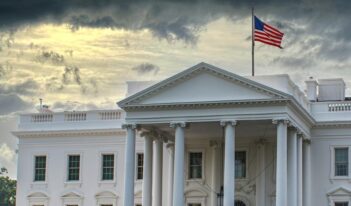
As the second Trump Administration begins, scholars reflect on the new book, How Government Built America.
What does history reveal about the relationship between government and free markets in the United States? In a new book, How Government Built America, legal scholars Sidney A. Shapiro and Joseph P. Tomain tackle that question. They argue that a close reading of history reveals that America’s fundamental political values of liberty, equality, fairness, and the common good can only be realized by carefully balancing government intervention with market enterprise.
Shapiro and Tomain argue that governmental action has always played a prominent role in the U.S. economy. They claim that the United States has always been driven by government and markets and that changes in the balance between the two are driven both by political figures and ordinary people. They also make a bolder claim: Neither government nor markets alone can align the United States with its fundamental values. According to Shapiro and Tomain, neoliberalism has tilted the balance too far towards markets and has failed to produce broad-based prosperity.
This series in The Regulatory Review focuses on Shapiro and Tomain’s book. It begins with an essay by Shapiro and Tomain in which they introduce the main themes of their book. It then features two thought-provoking essays by preeminent scholars reviewing the book.
With their own thoughts provoked by these reviews, Shapiro and Tomain offer separate essays building on each reviewer’s comments, essays that we shared with the book reviewers, who declined the invitation to respond further. The series then concludes with an overall reflective essay by Shapiro and Tomain in which they discuss how the “lessons” they draw from the historical interplay of government and markets can help put “the country’s current situation”—including recent Trump Administration initiatives—into what they see as an important perspective.
This series features contributions from: Edward J. Balleisen, a professor of history at Duke University; Sidney A. Shapiro, the Frank U. Fletcher Chair in Administrative Law at Wake Forest University School of Law; Joseph P. Tomain, the Dean Emeritus and Wilbert and Helen Ziegler Professor of Law at the University of Cincinnati College of Law; and Shelley Welton, the Presidential Distinguished Professor of Law and Energy Policy at the University of Pennsylvania Carey Law School.
How Government and Markets Built America Together
March 3, 2025 | Sidney A. Shapiro, Wake Forest University, and Joseph P. Tomain, University of Cincinnati
Government has always been involved in the evolution of America—and it will likely stay that way.
A Sorely Needed Defense of Government’s Possibilities
March 4, 2025 | Shelley Welton, University of Pennsylvania Carey Law School
Government regulation has played a crucial role in developing U.S. industries and improving citizens’ lives.
“Big” Government Protects American Values in a Big Economy
March 4, 2025 | Sidney A. Shapiro, Wake Forest University, and Joseph P. Tomain, University of Cincinnati
Their definitions and applications have evolved, but core American values have kept government and markets in dynamic equilibrium.
Regulatory Legacies and the Potential Limits of Trump 2.0
March 5, 2025 | Edward J. Balleisen, Duke University
Shapiro and Tomain’s new book highlights political and economic constraints on the incoming Trump Administration’s ability to achieve its goals.
Government as the Primary Influence on American Economic Development
March 5, 2025 | Sidney A. Shapiro, Wake Forest University, and Joseph P. Tomain, University of Cincinnati
Scholars respond to a review of their work and expand on the book’s lessons for the future.
Lessons From History Can Help Restore Stability
March 6, 2025 | Sidney A. Shapiro, Wake Forest University, and Joseph P. Tomain, University of Cincinnati
History suggests that public accountability and institutional checks can restore stability in government.



